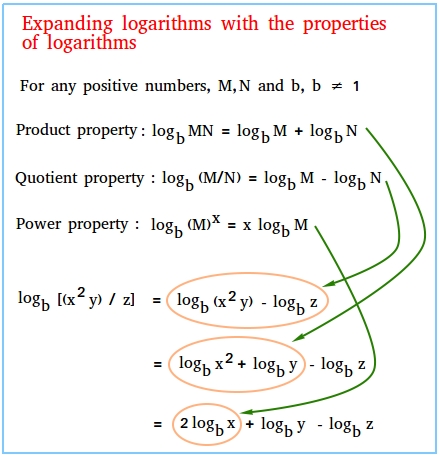Expanding logarithms
The examples below will teach you about expanding logarithms using the properties of logarithms, also called rules of logarithms. First study the example in the figure below carefully so that you can understand the process clearly.
Notice that after expanding logb[(x2y) / z] we get the expression below shown in blue.
2logb x + logb y - logb z
Notice also that expanding logarithms is the inverse of simplifying logarithms. You are trying to express a single logarithm into many individual logarithms.

How to use the rules of logarithms to expand a logarithmic expression
Let us see how we expanded the logarithmic expression logb[(x2y) / z] step by step.
To expand logb[(x2y) / z] you need to use a combination of the product property, the quotient property, and the power property.
First, use the quotient rule which says that the logarithm of a quotient is equal to the difference of the logarithms.
logb (M/N) = logb M - logb N
logb[(x2y) / z] = logb x2y - logb z
Second, use the product rule which says that the logarithm of a product is equal to the sum of the logarithms.
logb (MN) = logb M + logb N
Use the product rule to rewrite logb x2y.
logb[(x2y) / z] = logb x2 + logb y - logb z
Lastly, use the power rule which says that the logarithm of a power is equal to the exponent multiplied by the logarithm of the base of the exponential number.
logb (M)x = xlogb M
Use the power rule to rewrite logb x2.
logb[(x2y) / z] = 2logb x + logb y - logb z
More examples showing how expanding logarithms work
Example #1
Expand log5 (3xy)
In this example, you just need to use the product property.
log5 (3xy) = log5 3 + log5 x + log5 y
Example #2
Expand log (a2b3)
In this example, you need to use a combination of the product property and the power property.
log10 (a2b3) = log10 a2 + log10 b3
= 2log10 a + 2log10
Example #3
Expand log2 (5x / 10y)
In this example you need to use a combination of the product property and the quotient property.
log2 (5x / 10y) = log2 (5x) - log2 (10y)
= log2 (5) + log2 (x) - [ log2 (10) + log2 (y) ]
= log2 (5) + log2 (x) - log2 (10) - log2 (y)
= log2 (5) + log2 (x) - log2 (5×2) - log2 (y)
= log2 (5) + log2 (x) - (log2 5 + log2 2) - log2 (y)
= log2 (5) + log2 (x) - log2 5 - log2 2 - log2 (y)
= log2 (x) - log2 2 - log2 (y)
Notice that log2 (5) - log2 5 = 0
Notice also that if you remember to simplify a quotient, there will be less work to do as demonstrated below for example #3
log2 (5x / 10y) = log2 (x / 2y)
= log2 x - log2 2y
= log2 x - ( log2 2 + log2 y )
= log2 x - log2 2 - log2 y
How to expand the logarithm of a radical expression
To expand the logarithm of a radical expression, begin by rewriting the radical expression as a fractional exponent. Once you have done that, continue by applying the rules of logarithms.
Example #4
Expand log3 [ √ (36x3y) ]
Using a combination of the product property and the power property,
log3 [ √ (36x3y) ] = log3 [ (36x3y)1/2 ]
= 1/2 log3 (36x3y)
= 1/2 [ log3 (36) + log3 (x3) + log3 (y) ]
= 1/2 [ log3 (36) + 3log3 (x) + log3 (y) ]
= 1/2 log3 (36) + 3/2 log3 (x) + 1/2 log3 (y)
Notice that if you are trying to expand the natural logarithm of an expression, you can just use the rules mentioned in the figure above.
Example #5
Express ln 8x2y3 as a sum of 3 natural logarithms.
Use the product rule
ln 8x2y3 = ln 8 + ln x2 + ln y3
Use the power rule
ln 8x2y3 = ln 8 + 2ln x + 3ln y